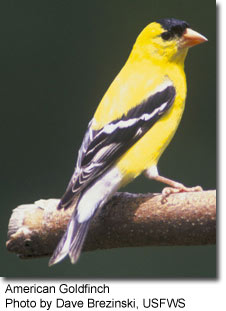American Goldfinch
(Carduelis tristis)
Description & Range:
A small songbird approximately 5” in size, the male in the summer time has a bright canary yellow body with black wings. forehead and tail. Female birds in the summer are a dull olive color, with black wings and noticeable wing bars. Both sexes have short conical bills. Winter: Both sexes look like the summer female but with more a grayish tint. Legs are light brown. Immature birds are a pale yellow prior to their first molt. Found year round in Maryland; found from Canada to Mexico.
Habitat:
Breeding habitat is old fields, woods edge, shrubs along ponds and streams and hedgerows. Winter – Birds become very wide spread, in weedy fields, hedgerows, and deciduous woods. Summer - Found in patches of thistles, dandelions on lawns, weedy gardens and roadsides.
Diet:
Primarily seed eaters. Will also eat aphids and caterpillars in the summer. Prefer the seeds of Ragweed, Thistles, Sweet gum, Sunflower, Dandelion, Alder, Goldenrod, Coneflower, Maples, Timothy Grass, Yellow Poplar, and Pine.
 Reproduction:
Reproduction:
The American Goldfinch is one of the last birds to breed in the summer, from late July to September. Goldfinches usually only produce one brood per season of four to six eggs. The female builds the nest, and incubates the eggs by herself. The eggs hatch in about 13 to 14 days, with the young staying in the nest another 14 days. The male does help the female in raising the young.
Nests are built in trees or shrubs 15 to 40 feet above the ground the average being 15 to 17 feet. These birds will not use old nests and will not use nesting boxes or platforms. Nests are often lined with thistle down and timing of breeding is based on the availability of thistle down.
Sounds:
Canary like. When the bird flies its unique up and down flight, it often sings t—dee-di-di.
Did you Know?
Goldfinches are very attracted to bird feeders filled with Niger (Thistle) seeds. The American Goldfinch is the official county bird of Howard County, Maryland. Goldfinches hull the seeds they are eating and will cut off any flowering plumes and other non-nutritious plant parts. These birds present a cheerful, social image when seen in flocks or flying through a backyard.